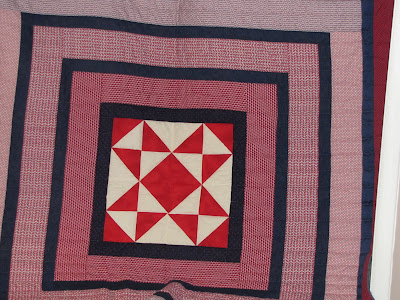Creating beauty from scraps is very satisfying. Scraps of fabric that seem insignificant by themselves can be joined with others to make something useful, beautiful, and lasting.
Recently, I finished a class where students were taught hand-quilting for a twelve week period. We literally quilted the winter away. The world is now better because there are three more quilts in it.
Funding for this class was provided by a grant from the Alabama State Council on the Arts. Thank you!!!
 Charlotte McDaniel (left) and Nancy Ledgewood work on Tulip Quilt, quilting around each piece.
Charlotte McDaniel (left) and Nancy Ledgewood work on Tulip Quilt, quilting around each piece. Wanda Robertson works on the Tulip quilt. An antique quilting frame was used to keep the layers together while they were being quilted.
Wanda Robertson works on the Tulip quilt. An antique quilting frame was used to keep the layers together while they were being quilted. Left to right: Wanda Robertson, JoAnn Haeger, Charlotte McDaniel, Nancy Ledgewood works on the Tulip Quilt.
Left to right: Wanda Robertson, JoAnn Haeger, Charlotte McDaniel, Nancy Ledgewood works on the Tulip Quilt.  An excellent way to spend a cold winter's evening!
An excellent way to spend a cold winter's evening! Tools needed for hand-quilting: strong thread, thimbles, needles, and glasses for most of us!
Tools needed for hand-quilting: strong thread, thimbles, needles, and glasses for most of us! Left to right: Nancy Ledgewood, Charlotte McDaniel, Jo Ann Haeger, Wanda Robertson, and Mitzi Hatton work on Christmas quilt using the fan pattern for quilting.
Left to right: Nancy Ledgewood, Charlotte McDaniel, Jo Ann Haeger, Wanda Robertson, and Mitzi Hatton work on Christmas quilt using the fan pattern for quilting. Charlotte McDaniel, Jo Ann Haeger, Wanda Robertson, and Mitzi Hatton. The white chalk lines remind us where the seam goes.
Charlotte McDaniel, Jo Ann Haeger, Wanda Robertson, and Mitzi Hatton. The white chalk lines remind us where the seam goes. Star quilt, with quilting lines drawn in chalk, thread, thimble, scissors used in quilting.
Star quilt, with quilting lines drawn in chalk, thread, thimble, scissors used in quilting. Left to right: Wanda Robertson, Charlotte McDaniel, Jo Ann Haeger, and Nancy Ledgewood
Left to right: Wanda Robertson, Charlotte McDaniel, Jo Ann Haeger, and Nancy LedgewoodStar quilt was quilted with straight lines except in the middle, where it was quilted around the pieces.

Completed Star Quilt
Completed Tulip Quilt
 Three finished quilts were raffled based on attendance. Jo Ann Haeger holds her Star Quilt.
Three finished quilts were raffled based on attendance. Jo Ann Haeger holds her Star Quilt. Charlotte McDaniel was the winner of the tulip quilt.
Charlotte McDaniel was the winner of the tulip quilt. Nancy Ledgewood was the winner of the Christmas Quilt.
Nancy Ledgewood was the winner of the Christmas Quilt.It is said that hand work is for the past; an artifact that is no longer needed. This theory couldn't be more wrong. Quilting is more popular today than it has ever been. Could that be because in this fast-paced culture, we are seeking something to slow us down, to calm us? Or because the world of Walmarts and eBay doesn't gratify our need to create, to surround ourselves with beauty?
Will the next generation produce any quilters? I don't have any idea how many, but I know there will be a least one!
 Ten-year-old Amanda Robertson quilts on the Christmas Quilt. Amanda couldn't attend the Tuesday night quilting bee, but did her work on Saturday.
Ten-year-old Amanda Robertson quilts on the Christmas Quilt. Amanda couldn't attend the Tuesday night quilting bee, but did her work on Saturday.
We know people have been quilting since records have been kept. Roman women, who lived before Jesus walked their roads, may have formed a group to quilt soft garments that their men wore under armor. They may have gathered in a circle to work on the quilted mats they used for their floors and wall.
Women who traveled in wagons with all their family and earthly belongings found time to quilt at the same time they were helping build a country. When their country became a battlefield, women quilted so their sons and husbands wouldn't have to sleep on the dirt.
For some of us, it is just something we have to do and teach. We have to make sure the next generation, children of the 21st century, like Amanda, have the skills needed to continue. I am thankful for the small contribution I have made in preserving this beloved art.








I can barely sew on a button-I wish I had learned to quilt as a child-like Amanda is. Looks like a wonderful time was had by all. I loved your words about the history of quilts too.
ReplyDelete(This spring was the first time I ever ate poke sallet-I like your post about it too)
Looks like fun! And lovely quilts to boot. :)
ReplyDeleteBeautiful! I wish I could've been a part of the class! Maybe next time. . . ;-)
ReplyDeleteIt was great fun! Thanks for the opportunity.
ReplyDelete